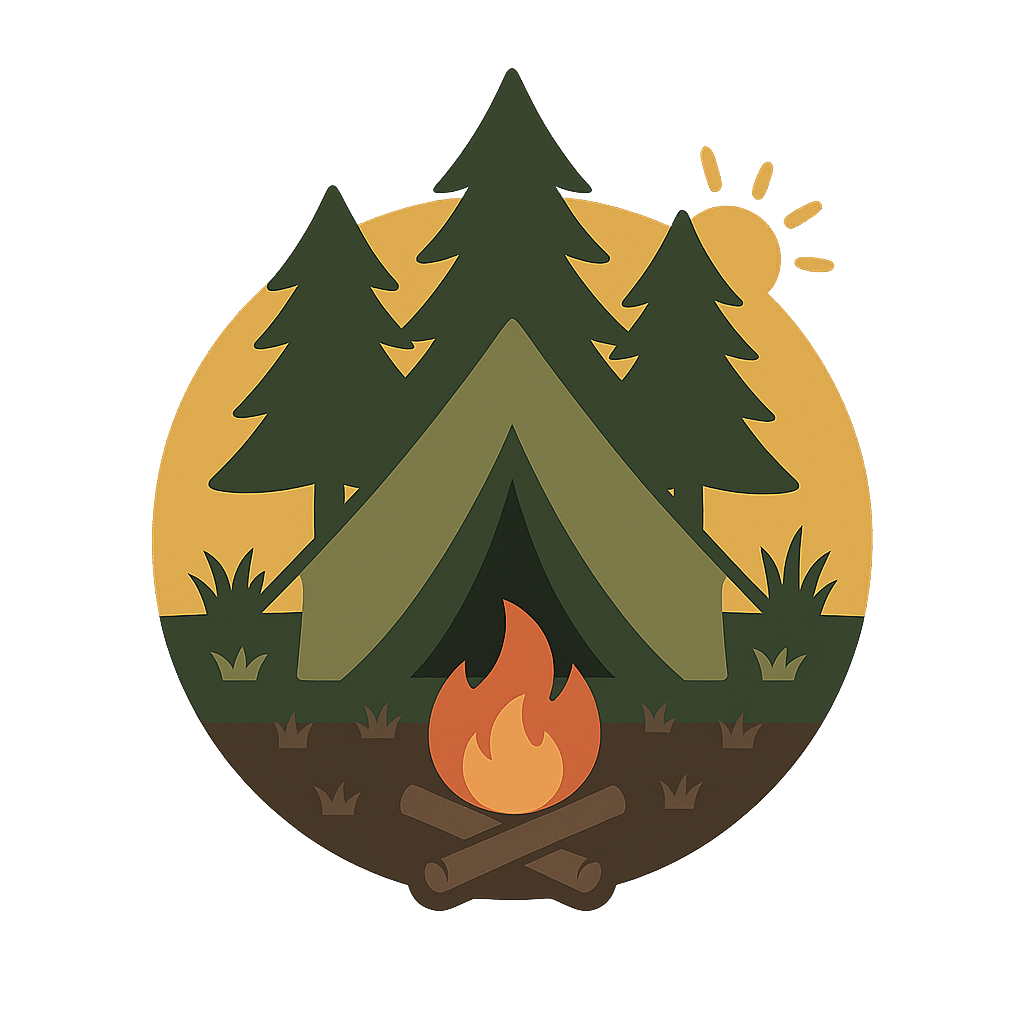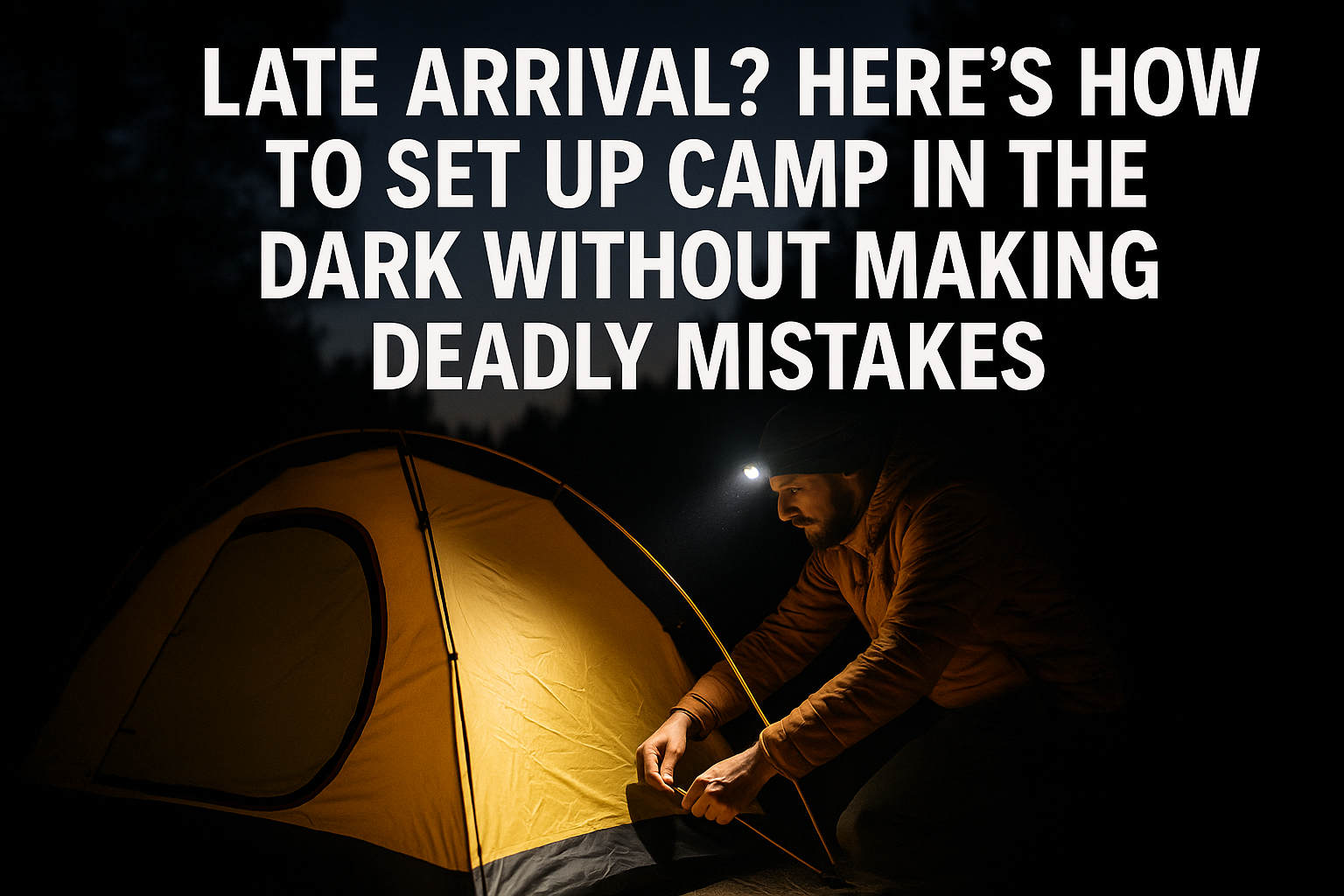You didn’t plan to arrive late.
But maybe the trail took longer than expected. Or your motorcycle broke down. Or the road signs lied.
Either way, it’s pitch black, you’re running on fumes, and now you have to build shelter in terrain you can barely see.
This is where most injuries and fatal errors happen.
It’s not just the darkness—it’s the fatigue, stress, and shortcuts people take when they’re cold, hungry, or scared. And it’s why night setups need more than common sense. They need pre-loaded decisions, tactile instincts, and field-aware thinking.
Let’s talk about how to set up camp at night—without flashlights, without panic, and without rookie mistakes.
🎯 1. Pre-Load Your Tent Like a Parachute
The biggest mistake people make when setting up in the dark? Fumbling with gear that’s still wrapped, tangled, or untested.
Before every trip, prep your tent as if you might need to deploy it blindfolded:
- Store it with the stakes and poles in order of use, not just crammed randomly.
- Attach reflective cordage to zippers and anchor points before the trip, not during setup.
- Color code poles with duct tape strips so you can ID them by feel.
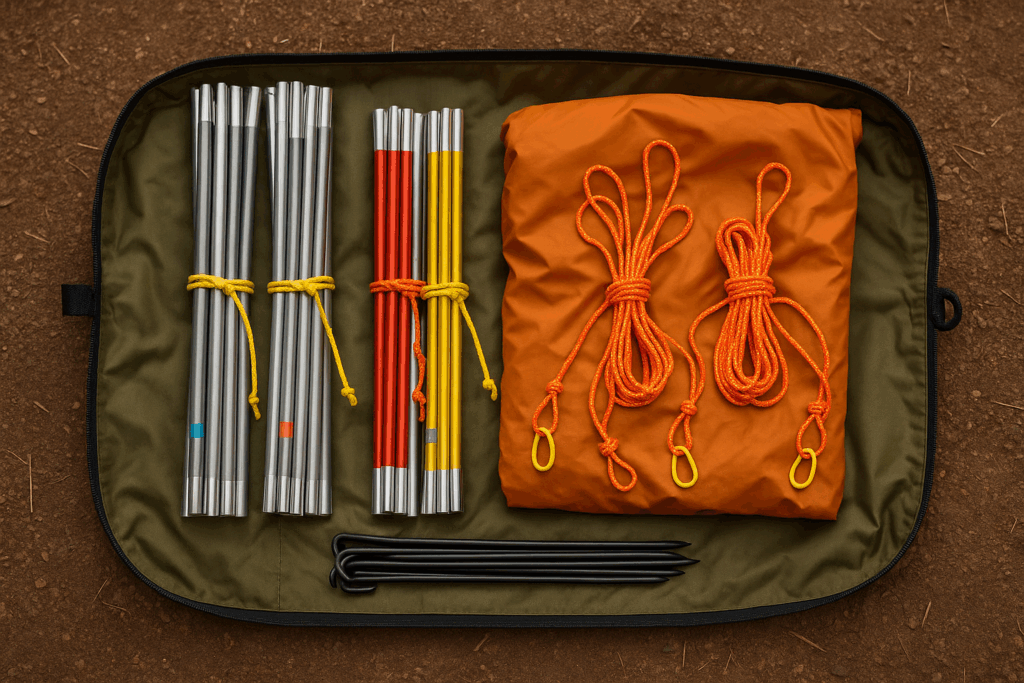
This “tactile pre-packing” means you don’t need to see the pieces—you need to know them.
It’s not about light. It’s about memory.
🌌 2. Choose Sites with Echo, Not Just Sight
In total darkness, your eyes lie—but sound doesn’t.
If you can’t see the ground clearly, stand still and clap or make a short vocal call.
- A tight echo? You’re near a rock wall or canyon—could be unstable, or prone to falling rocks.
- A hollow echo? Possible cave or sinkhole—move.
- No echo and muffled? Likely vegetation or sand—a safer bet for sleep.
Your ears can map terrain faster than a headlamp in many cases. Especially if there’s wind.
Pro tip: If the wind changes pitch or “pushes back,” it’s a sign you’re on a ridge or exposed cliff—back away before you drop gear.
🧭 3. Use Your Body to Test Slope & Drainage
Even in daylight, people camp on slopes and don’t realize it until they roll into a puddle or wake up with blood in their head.
At night, here’s the trick:
Lie down in your intended tent spot before setting anything up.
Feel where gravity pulls your weight. Feel if your hips are higher than your head.
If you start to slide or notice moisture seeping, you just saved yourself hours of suffering.
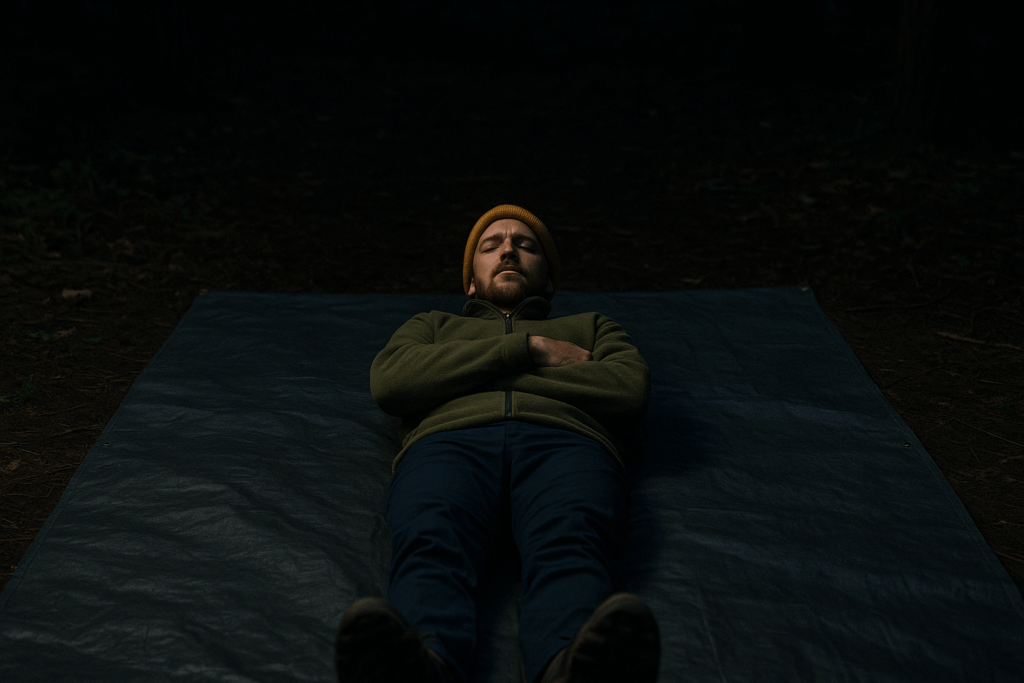
Advanced move: Do a barefoot scan—cold, mushy ground often means water channels or animal paths. Avoid.
🎒 4. Stage a Reverse Setup Kit
Most people keep gear organized for comfort: sleeping stuff here, food stuff there, tools in a pouch. But in emergencies or darkness, you want to reverse that logic.
Build a “First-Contact Kit” at the top of your pack, designed for late-night arrivals. It should include:
- Tent body and rainfly
- 4 stakes and guy lines pre-tied
- Groundsheet or emergency bivy
- Easy-access layer (gloves, hoodie)
- Energy chew or glucose tab
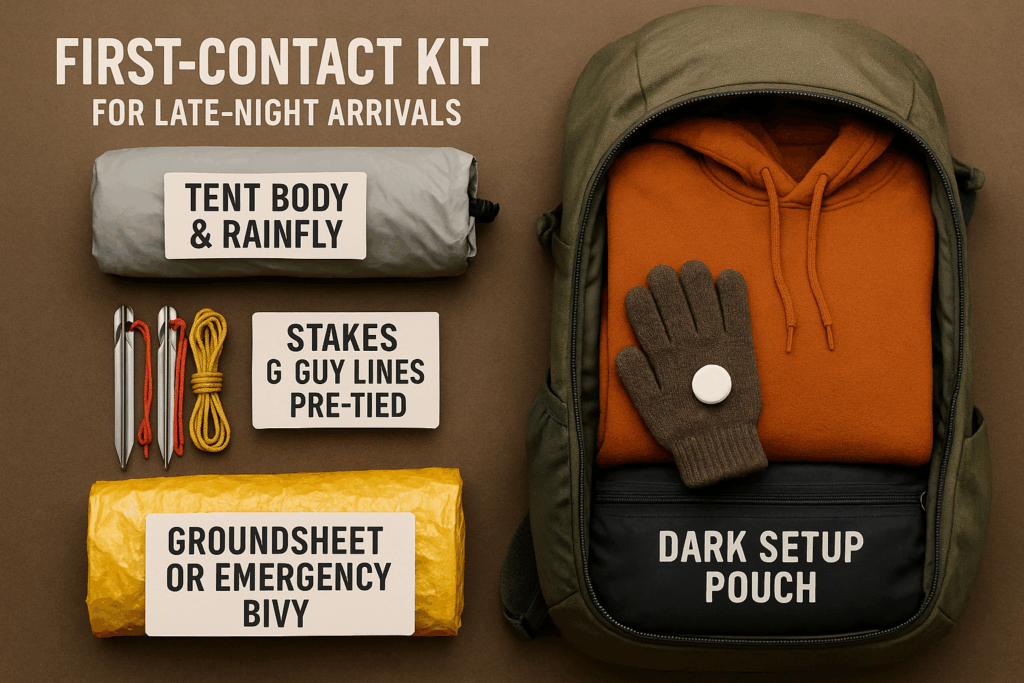
This lets you get covered in 3 minutes or less, even if your motor skills are failing.
🕳️ 5. Don’t Clear the Ground. Map It With Your Hands.
In daylight, you might clear sticks and rocks before pitching your tent.
At night, if you try that, you’ll either waste time—or worse, uncover scorpion nests, snakes, or ant colonies.
Instead, lay your groundsheet or jacket first, then crawl or press around it with open palms.
If you feel sharp shapes or movement under pressure, shift location slightly.
If it feels firm and quiet, build on top without disturbing the soil.
Desert and forest pests are more active at night. Don’t invite them in with your curiosity.
🐾 6. Avoid “Pretty” Spots—They’re Probably Dangerous
In the dark, you might default to what feels flat, open, and calm. But be warned:
Perfect-feeling flat spots at night are often dry stream beds (arroyos) or animal clearings.
If the ground is unusually soft and perfect underfoot, ask:
- Does it feel colder than the area around it?
- Is the surrounding terrain higher than you?
- Do you hear trickling or fluttering at a distance?
If yes, you’re likely in a flood channel or wildlife corridor. Move uphill at least 10–15 feet, even if it means a little tilt.

🌬️ 7. Read the Wind Like a Compass
Your tent may be freestanding, but a surprise gust at night can turn it into a parachute.
Before staking anything down:
- Wet your finger and rotate it to test airflow.
- If wind hits one side consistently, point your tent door away from that direction.
- Use your body weight to hold the windward edge of the tent down while staking the opposite corners first.
Wind is your early warning system: rapid, sudden shifts mean changing pressure. Could mean a storm, predator movement, or just bad placement.
🧠 8. Build “Blind Memory Maps” for Gear Retrieval
When setting up in the dark, most people lose time (and gear) because they place things instinctively, not intentionally.
Use this trick:
- Always place your headlamp, knife, and shoes in the same triangle next to your sleeping setup.
- Put your food or bear can exactly 30 paces from the tent, directly opposite the opening.
- Place your water bottle at the left-hand side of your head, with cap touching the tarp edge.
If you’re disoriented at 3AM, your hands will find what you need based on touch and habit—not vision.
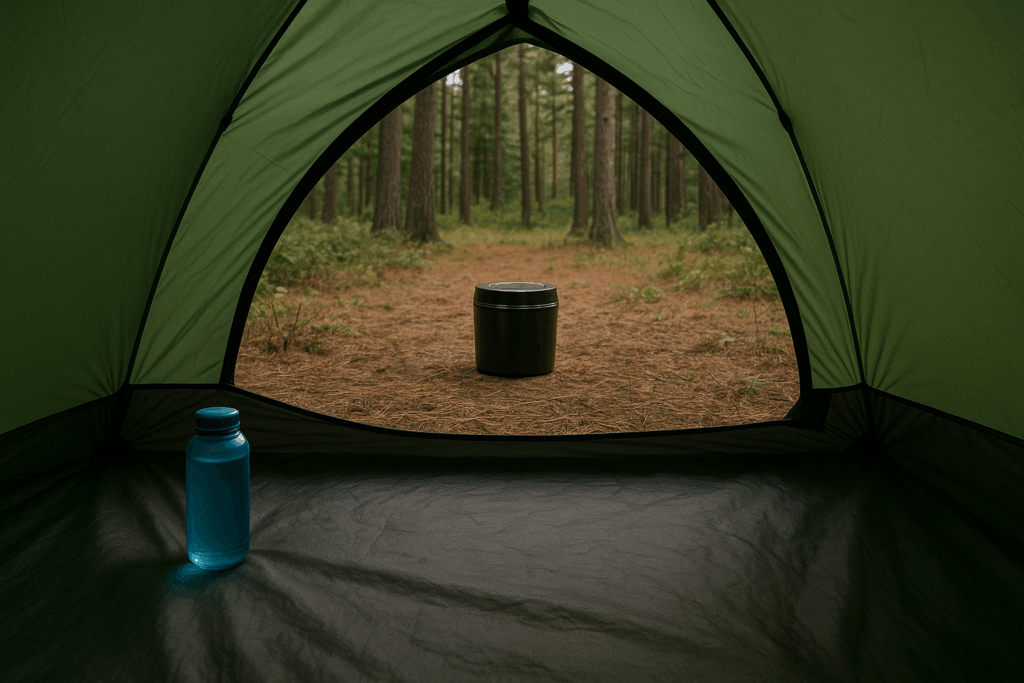
⚠️ Bonus Mistake to Avoid: Over-Correcting
When you can’t see, your instinct might be to “fix” everything—pulling tighter cords, re-staking pegs, re-centering the tarp.
Stop.
At night, small errors are less dangerous than full tear-downs.
Unless your tent is flapping wildly or your tarp collapsed, resist the urge to rebuild.
Over-correcting leads to stress, sweat, broken gear, and—often—panic spirals.
Instead:
Secure one stable corner.
Reinforce with body weight or gear bags.
Adjust in the morning.
🏁 Final Word: Darkness Is Just Untested Familiarity
Setting up camp in the dark isn’t about seeing better.
It’s about remembering differently.
If you train your gear, your muscle memory, and your environmental awareness to work without your eyes—you won’t fear the dark anymore.
Because it’s not the lack of light that gets people hurt.
It’s the lack of a plan.
